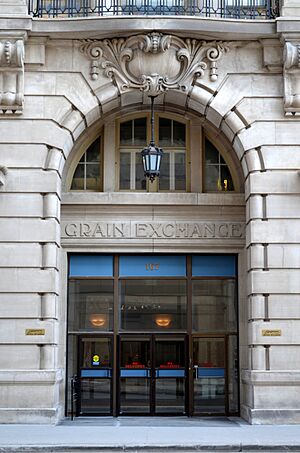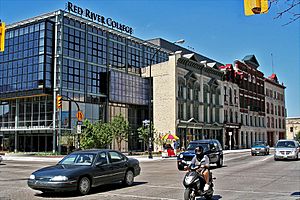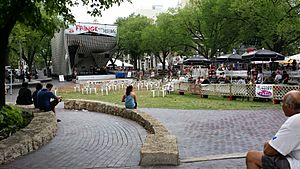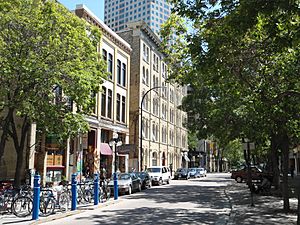Exchange District facts for kids
Quick facts for kids Exchange District |
|
|---|---|
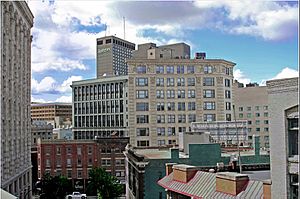
Buildings in Winnipeg's Exchange District
|
|
| Type | Neighbourhood |
| Location | Winnipeg, Manitoba, Canada |
| Founded | 1881 |
| Original use | Warehouse district |
| Current use | Mixed use |
| Governing body | Exchange District BIZ, Heritage Winnipeg |
| Lua error in Module:Location_map at line 420: attempt to index field 'wikibase' (a nil value). | |
The Exchange District is a cool historic area in downtown Winnipeg, Manitoba, Canada. It's just a block north of a famous spot called Portage and Main. This district covers twenty city blocks and has about 150 old buildings. It's famous for its well-preserved warehouses, banks, and early skyscrapers from the 1900s. Many buildings here are covered in a special type of clay tile called terra cotta.
The Exchange District is home to the Manitoba Museum, where you can learn about the province's history. It also has a Planetarium and a Science Gallery, which are great for exploring space and science.
The Exchange District has two main parts: the East Exchange and the West Exchange. The East Exchange is near the Disraeli Bridge and Main Street. The West Exchange is bordered by Adelaide Street and Notre Dame Avenue.
Contents
Discover the History of the Exchange District
The Exchange District got its name from the Winnipeg Grain Exchange. This was once the main place for buying and selling grain in Canada. Other trading markets also grew here between 1881 and 1918. Some of these markets are still active today.
Winnipeg grew super fast around the early 1900s. It was even called the "Chicago of the North." Many buildings from that time show the "Chicago style" of architecture. By 1911, Winnipeg was the third-largest city in Canada. It had many train lines and over 200 wholesale businesses.
However, things changed after World War I and when the Panama Canal opened in 1914. It became easier to ship goods using new routes. This slowed Winnipeg's growth. Other cities in Western Canada started their own wholesale businesses. So, Winnipeg's importance as a trading hub slowly went down. By the 1940s, many warehouses in the Exchange District were used for making clothes.
After World War II, Winnipeg started growing again. But new buildings were mostly built south of Portage Avenue. This meant the Exchange District stayed largely the same. Because of this, Winnipeg now has one of the best-preserved commercial areas from the early 1900s in North America.
In the early 1980s, the streets in the area were improved. They added wider sidewalks, old-fashioned streetlights, and special paving.
On September 27, 1997, the Exchange District was officially named a National Historic Site of Canada. This was a big deal for the area!
Fun Things to Do in the Exchange District
Today, the Exchange District is a lively place. It's full of unique shops, restaurants, nightclubs, art galleries, and apartments.
Enjoy Live Shows at Theatres
Winnipeg's theatre area is on the east side of the Exchange District. Here you'll find the Royal Manitoba Theatre Centre. There's also the Centennial Concert Hall, which hosts the Winnipeg Symphony Orchestra, the Royal Winnipeg Ballet, and the Manitoba Opera.
On the west side, you can visit Cinematheque. This is a small movie theatre inside the Artspace building on Albert Street.
Learn and Grow with Education Centers
Red River College has a large building here called the Roblin Centre. It's a huge building that mixes old building fronts with modern green technology. The Roblin Centre was built by joining five old buildings and a 1905 warehouse. About 2,000 students and 200 staff work here. They focus on modern media, computer technology, and business studies.
Another part of Red River College is the Paterson Globalfoods Institute. It opened in 2013 in the old Union Bank Building from 1903. This is where students learn about cooking, hospitality, and baking.
Explore Old Market Square
Old Market Square is a popular spot for festivals. It hosts the annual Jazz Winnipeg Festival and the Winnipeg Fringe Theatre Festival. Its cobblestone streets make it a great place for walking. It's also a popular spot for filming movies because of its old-time look. For example, parts of The Assassination of Jesse James by the Coward Robert Ford (with Brad Pitt) and The Lookout were filmed here.
Old Market Square started in 1889 as a public market. It was a busy center for trade in early Winnipeg. In the 1960s, the original market building was taken down. Later, in 1970, a group worked to save and improve the area.
In 1976, a group called Heritage Canada gave money to fix up buildings around Old Market Square. They focused on Albert Street, which became a place for a farmer's market. This helped bring new life to the area. In 1990, a permanent stage was built in the park.
From 2008 to 2012, the square got a big makeover. They improved the landscaping, seating, and lighting. The main new feature is "The Cube." This is a $1.5 million stage with a unique skin made of 20,000 aluminum links. It has special lights and two performance levels. The Cube can open up to show the stage inside.
The Cube has had some problems since it opened. Repairs are planned to fix the lights, fans, and make it more accessible.
There are also plans to redevelop the old Public Safety Building site. This new area, called Marketlands, might have a farmers market and homes.
Getting Around the Exchange District
The Exchange District is easy to get around.
Roads for Driving
There are no fast highways going through the Exchange District. Cars drive at regular city speeds on streets like Portage Avenue and Main Street.
Cycling Paths
You can find a painted bike lane along McDermot Avenue. It goes between Main Street and the HSC campus.
Public Transit
Many city buses travel through the Exchange District. This makes it easy to reach by public transport.
Boat Access (Future Plans)
The Alexander Docks used to be a place where tourist boats docked. It's currently closed for updates. There are plans to make it a modern waterfront area again.
Exciting Future Plans
There are several ideas to make the Exchange District even better.
Albert Street Pedestrian Mall
In 2010, an idea came up to turn two blocks of Albert Street into a pedestrian mall. This means it would be closed to cars. The goal is to make the area even more special and attract more visitors.
Centennial Centre Upgrades
The Centennial Centre, which includes the Concert Hall, Theatre Centre, Museum, and Planetarium, is over 50 years old. There are plans to upgrade and expand these venues.
Alexander Docks Redevelopment
The city wants to redevelop the Alexander Docks site. It was built in 1929. There are plans for a small hotel and a marina there. In 2018, a design competition was held for the docks. The winning design was called "Alexander's Garden."
Who Lives in the Exchange District?
The Exchange District is growing! In 2016, about 630 people lived here, which was a big increase from 2011. This area makes up a small part of Winnipeg's total land.
People of all ages live in the district, from young adults to older residents. Many people who work in the district choose to walk as their main way to get around. This is much higher than in other parts of Winnipeg.


